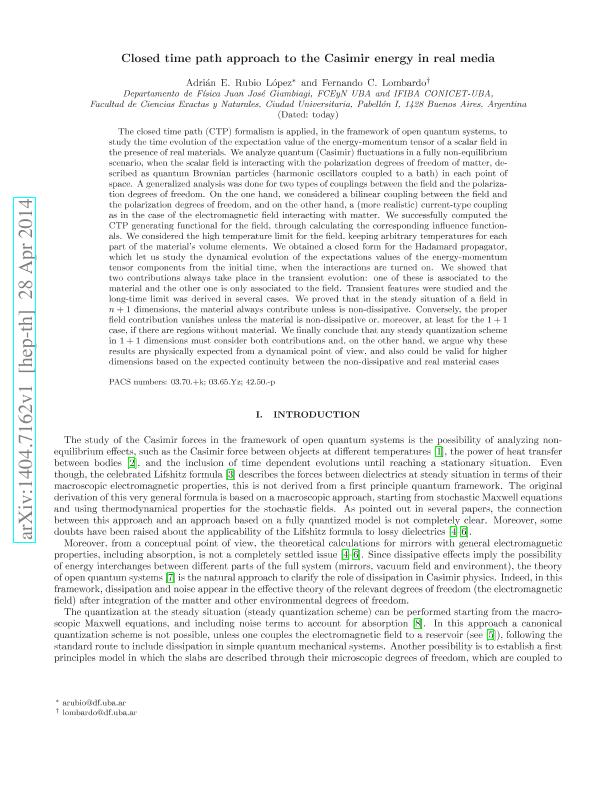Mostrar el registro sencillo del ítem
dc.contributor.author
Rubio Lopez, Adrian Ezequiel

dc.contributor.author
Lombardo, Fernando Cesar

dc.date.available
2017-06-09T17:41:08Z
dc.date.issued
2014-05
dc.identifier.citation
Rubio Lopez, Adrian Ezequiel; Lombardo, Fernando Cesar; Closed-time-path approach to the Casimir energy in real media; American Physical Society; Physical Review D; 89; 10; 5-2014; 1-26; 105026
dc.identifier.issn
0556-2821
dc.identifier.uri
http://hdl.handle.net/11336/17885
dc.description.abstract
The closed-time-path (CTP) formalism is applied, in the framework of open quantum systems, to study the time evolution of the expectation value of the energy-momentum tensor of a scalar field in the presence of real materials. We analyze quantum (Casimir) fluctuations in a fully nonequilibrium scenario, when the scalar field is interacting with the polarization degrees of freedom of matter, described as quantum Brownian particles (harmonic oscillators coupled to a bath) at each point of space. A generalized analysis is done for two types of couplings between the field and the polarization degrees of freedom. On the one hand, we consider a bilinear coupling between the field and the polarization degrees of freedom, and on the other hand, a (more realistic) current-type coupling as in the case of the electromagnetic field interacting with matter. We successfully compute the CTP generating functional for the field through calculating the corresponding influence functionals. We consider the high-temperature limit for the field, keeping arbitrary temperatures for each part of the material’s volume elements. We obtain a closed form for the Hadamard propagator, which allows us to study the dynamical evolution of the expectations values of the energy-momentum tensor components from the initial time when the interactions are turned on. We show that two contributions always take place in the transient evolution: one is associated with the material, and the other is only associated with the field. Transient features are studied and the long-time limit is derived in several cases. We prove that in the steady situation of a field in n þ 1 dimensions, the material always contributes unless it is nondissipative. Conversely, the proper field contribution vanishes unless the material is nondissipative or—at least for the 1 þ 1 case—if there are regions without material. We finally conclude that any steady quantization scheme in 1 þ 1 dimensions must consider both contributions and, on the other hand, we argue why these results are physically expected from a dynamical point of view, and also could be valid for higher dimensions based on the expected continuity between the nondissipative and real-material cases.
dc.format
application/pdf
dc.language.iso
eng
dc.publisher
American Physical Society

dc.rights
info:eu-repo/semantics/openAccess
dc.rights.uri
https://creativecommons.org/licenses/by-nc-sa/2.5/ar/
dc.subject
Nonequilibrium Quantum Field Theory
dc.subject
Casimir Effect
dc.subject
Open Quantum System
dc.subject.classification
Física de Partículas y Campos

dc.subject.classification
Ciencias Físicas

dc.subject.classification
CIENCIAS NATURALES Y EXACTAS

dc.title
Closed-time-path approach to the Casimir energy in real media
dc.type
info:eu-repo/semantics/article
dc.type
info:ar-repo/semantics/artículo
dc.type
info:eu-repo/semantics/publishedVersion
dc.date.updated
2017-06-09T14:19:27Z
dc.journal.volume
89
dc.journal.number
10
dc.journal.pagination
1-26; 105026
dc.journal.pais
Estados Unidos

dc.journal.ciudad
Nueva York
dc.description.fil
Fil: Rubio Lopez, Adrian Ezequiel. Consejo Nacional de Investigaciones Científicas y Técnicas. Oficina de Coordinación Administrativa Ciudad Universitaria. Instituto de Física de Buenos Aires. Universidad de Buenos Aires. Facultad de Ciencias Exactas y Naturales. Instituto de Física de Buenos Aires; Argentina
dc.description.fil
Fil: Lombardo, Fernando Cesar. Consejo Nacional de Investigaciones Científicas y Técnicas. Oficina de Coordinación Administrativa Ciudad Universitaria. Instituto de Física de Buenos Aires. Universidad de Buenos Aires. Facultad de Ciencias Exactas y Naturales. Instituto de Física de Buenos Aires; Argentina
dc.journal.title
Physical Review D

dc.relation.alternativeid
info:eu-repo/semantics/altIdentifier/doi/http://dx.doi.org/10.1103/PhysRevD.89.105026
dc.relation.alternativeid
info:eu-repo/semantics/altIdentifier/url/https://journals.aps.org/prd/abstract/10.1103/PhysRevD.89.105026
dc.relation.alternativeid
info:eu-repo/semantics/altIdentifier/url/https://arxiv.org/abs/1404.7162
Archivos asociados
